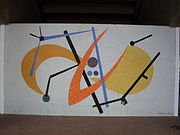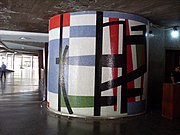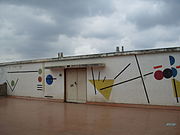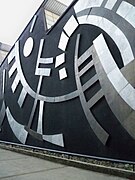
The Central University of Venezuela is a public university located in Caracas, Venezuela. Founded in 1721, it is the oldest university in Venezuela and one of the oldest in the Western Hemisphere.

Carlos Raúl Villanueva Astoul was a Venezuelan modernist architect. Raised in Europe, Villanueva went for the first time to Venezuela when he was 28 years old. He was involved in the development and modernization of Caracas, Maracay and other cities across the country. Among his works are El Silencio Redevelopment which included 7797 apartments and 207 shop premises and the Ciudad Universitaria, the main campus of the Central University of Venezuela. The Campus was declared a World Heritage Site by UNESCO in the year 2000.
Venezuelan art has a long history. Initially dominated by religious motifs, art in Venezuela began emphasizing historical and heroic representations in the late 19th century, a move led by Martín Tovar y Tovar. Modernism took over in the 20th century. Notable Venezuelan artists include Arturo Michelena, Cristóbal Rojas, Armando Reverón, Manuel Cabré, the kinetic artists Jesús-Rafael Soto and Carlos Cruz-Diez, the Meta-realism artist Pajaro and Yucef Merhi.

The University City of Caracas, also known by the acronym CUC, is the main campus of the Central University of Venezuela (UCV), located in central Caracas, the capital of Venezuela. It was designed by the Venezuelan architect Carlos Raúl Villanueva and was declared a World Heritage Site by UNESCO in 2000. The Ciudad Universitaria de Caracas is considered a "masterpiece" of architecture and urban planning, and greatly influenced Venezuelan architecture.

Alejandro Otero was a Venezuelan painter of Geometric abstraction, a sculptor, a writer and a cultural promoter. He was a founding member of the Los Disidentes group.

The Birthplace of Simón Bolívar is a seventeenth-century house in the Venezuelan capital city Caracas where the hero of Venezuelan and Latin American independence, Simón Bolívar, was born. Now a significant tourist attraction, the building is located in a little street off the Plaza San Jacinto, a block east of the Plaza Bolívar. It is one of only a few houses from the colonial era which survive in central Caracas.

The Hospital Universitario de Caracas or University Hospital of Caracas is a publicly owned hospital located in the spaces of the Ciudad Universitaria de Caracas, part of the Central University of Venezuela, located in the Chaguaramos parish of Libertador Municipality in the District Capital of Venezuela and west of Caracas Metropolitan District and the city of Caracas, the north central Venezuela.

The Aula Magna is an auditorium at the Central University of Venezuela. It is located within the University City of Caracas, next to the University's main library building. The hall was designed by the Venezuelan architect Carlos Raúl Villanueva in the 1940s and built by the Danish company Christiani & Nielsen from 1952–53. It was declared a UNESCO World Heritage Site in November 2000 for being artistically and architecturally significant. The most notable feature of the hall is its acoustic 'clouds', which serve both aesthetic and practical functions. They are an element of the hall's design which contributed to the science of interior space acoustics, though the building exterior is also architecturally significant.

Tierra de nadie is the unofficial name of a public green space officially called Plaza Jorge Rodríguez in the University City of Caracas, the campus of the Central University of Venezuela.

The Covered Gymnasium of UCV is a multi-purpose gym located in the University City of Caracas. Its spaces are public property that is administered by the Central University of Venezuela through the UCV sports department.

Ciudad Universitaria is a Caracas Metro station on Line 3. It was opened on 18 December 1994 as part of the inaugural section of Line 3 from Plaza Venezuela to El Valle. The station is between Plaza Venezuela and Los Símbolos.

Conductores de Venezuela is a giant ceramic mural on a wall outside the Covered Gymnasium at the Central University of Venezuela, facing out to the Francisco Fajardo freeway. It was designed by cartoonist Pedro León Zapata and installed over a period of years in the late 1990s; it depicts cartoon Venezuelan people driving, with several vehicles having important Venezuelans from history behind the wheel.

Rectory Plaza, originally The Empty Plaza, is the name of a space located within the University City of Caracas, the campus of the Central University of Venezuela, in the San Pedro parish in the west of the city of Caracas.

The Biblioteca Central de la UCV, or Central Library is the main library in the University City of Caracas, and the most important one of the Central University of Venezuela. It is easily accessible from anywhere in the city as it is near the Caracas Metro line 3 station Ciudad Universitaria.

The UCV Clock Tower, also known by its Spanish name Torre del Reloj de la UCV, or Reloj de la UCV, is a monument made of prestressed concrete. It is by the Rectory Plaza of the Central University of Venezuela in the University City of Caracas, and was built between 1953 and 1954.
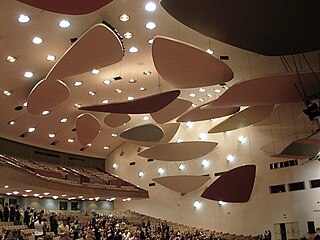
Floating Clouds is a work of art by American sculptor Alexander Calder, located in the Aula Magna of the University City of Caracas in Venezuela. The 1953 work comprises many 'cloud' panels that are renowned both artistically and acoustically. The piece is seen as "one of Calder's most truly monumental works" and the prime example of the urban-artistic theory of campus architect Carlos Raúl Villanueva.

Francisco Narváez was commissioned to create pieces for the University City of Caracas campus in 1949, initially working between 1950 and 1953, with other pieces added later. The artworks include stone and metal statues, busts, reliefs, and various material of murals. Three of the statues are made of Cumarebo stone: El Atleta, a large statue in the sports complex, and La educación and La ciencia in the medical complex. The Cumarebo stone is a favourite material of Narváez. Two sculptures of the esteemed doctor José Gregorio Hernández and President José María Vargas grace the campus grounds.

Berger des Nuages, Pastor de Nubes, or Cloud Shepherd is a work of art by Jean Arp just outside the Plaza Cubierta of the University City of Caracas.
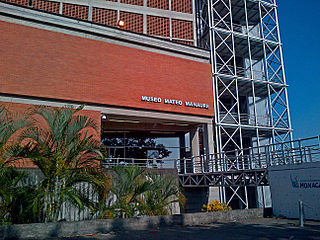
Mateo Manaure was a Venezuelan modern artist. In Venezuela he is considered a master of abstractionism, and is known for his works in the University City of Caracas and for creating the largest glass mural in the world.


